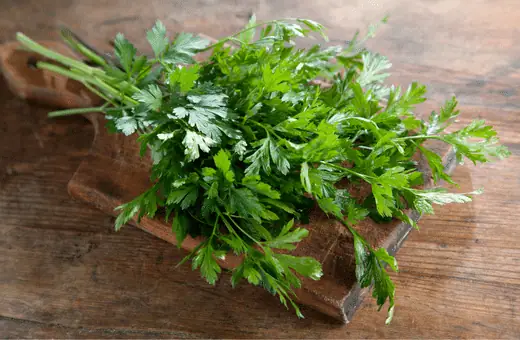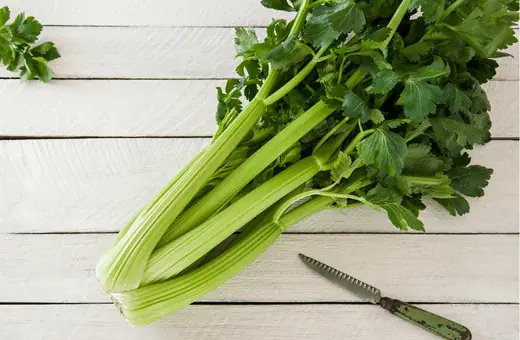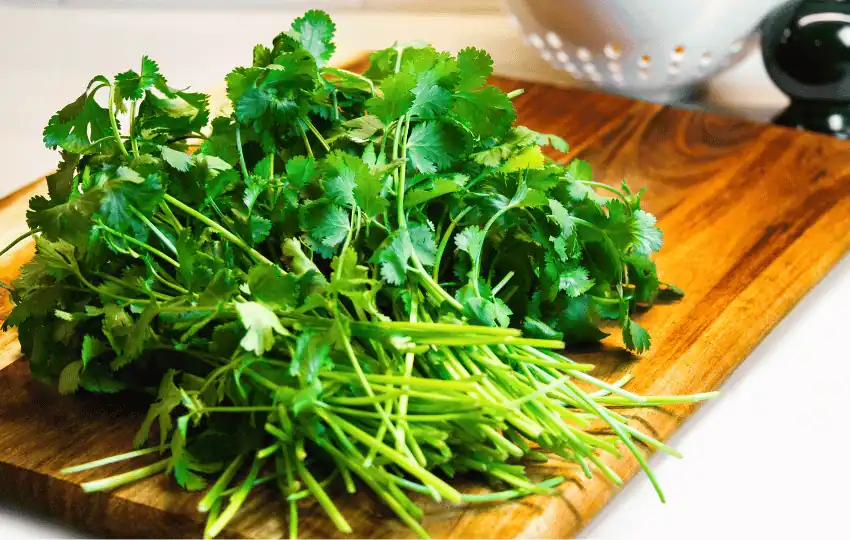Cilantro is an aromatic herb used in many different cuisines from around the world.
Its unique flavor and aroma make it a popular addition to recipes, but unfortunately, some people are genetically predisposed to find cilantro flavor unpleasant.
For those who can’t tolerate cilantro, there are several alternatives that can be used.
To create it easier to pick the right one, let’s take a look at some of the best substitutes for cilantro and how they can be used in cooking.
Let’s get started!
Are cilantro and coriander the same thing?
Cilantro and coriander are often confused, but they are actually two different plants. Cilantro (Coriandrum sativum) is the leaves of the plant, while coriander (or ground coriander) is the seeds from the same plant.
Cilantro has a bright and citrusy flavor that works well in salsas and salads, while coriander has a nutty, earthy flavor that works well in curries and soups.
Both can be used to season dishes, but they should not be used interchangeably as their flavors are quite different.
To get the most out of both cilantro and coriander, use them fresh for maximum flavor. That way, you’ll get the best of both worlds!
Read more: Creole seasoning alternatives
Best Cilantro substitutes from your Pantry
1. Coriander seeds
Coriander seeds can be used as a great substitution for cilantro in both cooked and uncooked dishes.
This herb has a citrusy, nutty flavor that pairs well with many spices and ingredients. The fact that it’s dried makes it a great option when fresh cilantro is unavailable or difficult to find.
It’s also a great way to add an extra layer of flavor and aroma to dishes.
It can be used as a base in marinades, sauces, soups, stews, curries, and other dishes. Similarly, it can be added as a finishing touch to salads or sprinkled on top of cooked grains for added texture and flavor.
You can also experiment with using it in baking or making your own herbal teas and infusions.
Coriander seeds can also be used to make a flavorful pickle that adds a unique twist to any meal.
No matter how you use coriander, it is sure to make your dishes more aromatic and flavorful. Have fun experimenting with this versatile and delicious herb!
2. Parsley
Parsley is a great substitute for cilantro due to its mild flavor and subtle earthy notes.
It can be used in equal amounts as a replacement for cilantro, or you can use half the amount of parsley as you would use cilantro if you prefer a more subtle flavor.
Parsley is low in calories, yet high in vitamins A, C, and K. It is also a great source of iron and other minerals like magnesium and potassium.
Eating parsley can help to boost your antioxidant intake and promote overall health.
However, parsley is probably the most common substitution for cilantro. This leafy green herb has a milder flavor than cilantro and can be used as a garnish or added to salads, soups, sauces, and stews.

It’s important to note that flat-leaf parsley has a more intense flavor than curly parsley, so use it sparingly if you choose this option!
In addition to cooking, parsley can be used medicinally. Its essential oil is rich in compounds that can help with inflammation, digestion, and even respiratory issues.
It can be taken as a tea or tincture, used topically, or ingested in capsule form.
It is easy to incorporate parsley into your diet. Try adding it to omelets, salads, pasta dishes, or even fruit smoothies for an extra nutritional punch!
The vibrant green leaves also make a beautiful garnish for dishes or drinks.
Try growing some in your garden or buying it at the grocery store to get the full culinary and health benefits.
No matter how you use it, parsley is sure to add a delicious flavor and nutrition boost to your meals.
Parsley is widely available and can be found in supermarkets and specialty stores alike.
3. Vietnamese coriander
Vietnamese coriander (also known as Vietnamese mint) is another great option for replacing cilantro.
This herb has a slightly spicy flavor that pairs well with Asian dishes such as pho, curries, and stir-fries.
Use sparingly as it has an intense flavor and can easily overpower other ingredients in a dish.
4. Caraway
Caraway is a spice that has been used for centuries to give dishes an aromatic, earthy flavor. Native to Europe, caraway is now grown in many parts of the world and is popular as a seasoning in many cultures.
The seeds have an anise-like aroma and can be used whole or ground up when cooking. In place of caraway, you can use cumin or fennel seeds if preferred.
It adds a unique flavor to many dishes including stews, soups, vegetables, marinades, and more.
When using caraway in recipes, it is best to add it at the beginning of cooking so that the flavors can be absorbed into the food before serving.
It is also be used as a garnish or topping on salads, soups, and stews. Additionally, caraway oil can be used for flavoring.
Caraway can easily be added to dishes as it is readily available in both seed and ground form.
5. Thai basil
Thai basil is a popular herb used in Southeast Asian cuisine that can be interchanged with cilantro in many recipes.
This fragrant and pungent herb has an anise-like flavor that adds zest to dishes. It has slender leaves, which are much smaller than those of cilantro, and its stems have a purple hue.
The flavor of Thai basil is quite different than that of cilantro, with more of an anise-like taste.
Thai basil is often used in sauces, curries, and soups, as well as stir-fry dishes and salads.
Its unique flavor adds a hint of complexity to recipes and can be combined with other herbs and spices to create unique flavor combinations.
It is also be used to garnish dishes or as a fresh herbal tea.
When using Thai basil, it is important to remember that its intense flavor should not be cooked for too long, as this will lessen its flavor.
To preserve its fragrance and taste, it is best added at the end of cooking.
Thai basil can be stored in the refrigerator for up to a week, although it is best used right away for maximum flavor.
If you are unable to find fresh Thai basil, dried or frozen versions are also available in most grocery stores and specialty stores.
6. Dill+ Oregano
Dill and oregano are both members of the Apiaceae family, which is more commonly known as the carrot or parsley family.
This means that their flavors share many similarities and make them excellent substitutes for cilantro in a variety of dishes.
The easiest way to substitute cilantro with dill and oregano is to simply use the same amount of each herb in place of cilantro.
This is a good option if you like to keep the flavor profile similar without overpowering it with too much dill or oregano.
However, if you want to experiment a bit more, consider using slightly more oregano than dill as this will bring out a more complex flavor.
When using a combination of dill and oregano as a cilantro substitute, remember to take into account the fact that these herbs are much milder than cilantro.
If you’re making a dish that calls for a lot of cilantro, consider adding more dill and oregano to compensate for the lack of flavor.
Another way to use dill and oregano as cilantro substitutes is to mix them together in equal parts and use them as a single ingredient.
This option is great for dishes that call for both herbal flavors but don’t require the distinct flavor of cilantro. The blend of dill and oregano can add subtle complexity to the dish while still providing plenty of herbaceous flavors.
Finally, if you want to go the extra mile, consider adding a bit of lemon juice to the dish to bring out the flavors of dill and oregano even more.
This can be a great way to brighten up any dish that has been missing cilantro’s signature citrus flavor.
Overall, dill and oregano make excellent substitutes for cilantro. Although they don’t have the same distinctive flavor, they can still provide plenty of flavor and complexity to a dish.
With a bit of experimentation, you can find the perfect balance between dill and oregano that best replaces cilantro in your favorite recipes.
7. Mint
Mint has a bright, invigorating flavor that pairs well with many dishes. It has notes of peppermint and spearmint that provide a cool, refreshing finish to recipes.
When substituting mint for cilantro, use twice as much since mint has a more delicate flavor than cilantro does.
Additionally, mint should be added towards the end of cooking as its delicate flavors will dissipate if cooked too long.
8. Curry Powder
It generally features a combination of coriander seed, cumin seed, turmeric, ginger root, garlic powder, and other herbs and spices.
By using curry powder instead of fresh cilantro, ginger, and other spices, you can save time in the kitchen, allowing you to enjoy your favorite Indian dishes with less preparation.
Plus, curry powder adds a delicious depth of flavor that no single spice could provide.
Curry powder is a savory blend of spices used in a variety of dishes, including curries, soups, stews, and sauces.
Try experimenting with different brands or recipes of curry powder to find the one that suits your tastes best.
Some curry powders are more pungent, while others are milder. If you like a spicier flavor, try adding red chili pepper or cayenne to your curry powder.
And don’t be afraid to mix and match your spices – experiment with different combinations of coriander, cumin, turmeric, ginger root, garlic powder, and other herbs to create your own unique blends.
With a little experimentation, you can find the perfect curry powder for your palate.
Read more: Best Madras curry powder substitutes
9. Fresh Celery Leaves
Fresh celery leaves are an excellent substitute for cilantro in many dishes. Celery leaves provide a unique, fresh taste that is similar to cilantro but has its own distinct flavor.
Celery leaves have a slightly bittersweet taste and can be used as a garnish or herb in place of cilantro.
They can be added to soups, salads, dips, and sauces for added flavor.

Celery leaves can be used in many dishes to add a unique twist or extra crunch. They are especially delicious when tossed into stir-fries or used to top tacos.
Celery leaves can also be used in sauces to provide a touch of sweetness or added to soups and stews for extra flavor.
For an easy way to enjoy the benefits of celery leaves, try adding them to your favorite salad dressing. Enjoy!
10. Papalo
Substitute Papalo for cilantro. Papalo, also known as Mexican Coriander, has a more intense flavor than cilantro.
In addition to its flavorful qualities, it is also a great source of Vitamin C and potassium, making it a healthy addition to your diet.
It is a strong herb that works well in many dishes, such as soups, salads, salsa, and tacos. Papalo can be used fresh or dried to bring an authentic Mexican flavor to your recipes.
If you are searching for an easy way to add some Mexican flavor to your cooking, give Papalo a try! You won’t be disappointed.
When cooking with Papalo, always remember to use it sparingly, as it is a strong herb; a little goes a long way!
You can also blend it into a paste and store it in an airtight container in the refrigerator for later use. Give Papalo a try and bring some Mexican flavor to your kitchen!
Papalo is widely used in South American cuisine and can be found in many Latin supermarkets and online.
11. Mixed Herbs
When it comes to making your own guacamole, you have a few different options. You can stick with the classic combination of garlic, onion, jalapeno pepper, and cilantro – or you can get creative!
Try using other herbs like parsley or chives instead of cilantro for a unique twist. You can also add lime juice, tomato, or even mango for even more flavor.
And don’t forget about spices – a pinch of cumin and chili powder can really enhance the taste. Finally, if you don’t have any fresh herbs on hand, try using dried mixed herbs instead.
Whichever combination you choose, guacamole is a delicious way to enjoy avocados!
This combination adds an amazing range of flavors to any meal; the unique blend of these complementary herbs provides depth and complexity to the dish.
Plus, with a mix like this, you don’t have to worry about overpowering your meal with cilantro if it’s not your favorite.
Mixed herbs are also incredibly versatile and can be used in virtually anything from salads to omelets or pizza toppings.
No matter what type of cuisine you’re making, adding herbs is always a great way to add more flavor and depth to any meal.
So next time you’re in the market for some extra flavor, grab a handful of mixed herbs and let them add an amazing layer of flavor to your dish.
12. Culantro
Culantro, sometimes referred to as ‘Mexican coriander,’ is an herb native to Central and South America. It has long, serrated leaves that have a strong and sharp flavor, similar to cilantro but more intense.
Culantro is full of vitamins, minerals, and antioxidants that provide numerous health benefits.
It can help reduce inflammation, improve digestion, reduce cholesterol levels, and even support weight loss. Culantro is a flavorful and nutritious addition to any meal or snack.
Culantro is becoming increasingly popular in many dishes, especially in Mexican cuisine.
It is often used as a garnish, but it can also be used to season meats and seafood. Try adding it to tacos, salads, soups, and salsas for a delicious new flavor.
Culantro can be found fresh in most Latin American markets or online.
You can also find dried or powdered versions of culantro if you don’t have access to the fresh herb.
Enjoy experimenting with different flavors and spices to create your own unique culinary experiences. Bon Appetit!
FAQs on cilantro substitute
Q1. What tastes closest to cilantro?
Parsley and coriander both have a similar flavor to cilantro, with parsley being slightly milder. Coriander is the dried form of cilantro, so it has an even stronger flavor. Other herbs like basil or mint are also often used as substitutes for cilantro in various recipes.
Additionally, different types of lettuce can also be used as a substitute, such as romaine or butter lettuce. These lettuces have a milder flavor than cilantro, but they still offer the same crunch and texture to dishes.
Finally, some people prefer to use green onions instead of cilantro for their recipes since they have a similar flavor profile.
Q2. What can I use in place of cilantro in salsa?
If you don’t have cilantro available for your salsa, there are a few alternatives that can be used. Parsley is one of the most common replacements for cilantro, as it has a similar herby flavor profile.
You can also use fresh basil or oregano to add some additional herbal notes to your salsa. Another option is to use a combination of freshly chopped onions, peppers, and garlic, which will provide some spice and flavor without the cilantro.
Finally, you can also try adding some additional spices, such as paprika or chili powder, to give the salsa a little extra kick. Whatever you decide, be sure to adjust your recipe accordingly so that it still tastes great!
Q3. Can you substitute green onion for cilantro?
Yes, in some recipes, it is possible to substitute green onion for cilantro. However, keep in mind that the two herbs have very different flavors. Green onion has a milder flavor than cilantro and can be used as a topping or in salads and salsas. Cilantro has a strong, distinctive flavor that may not be compatible with all recipes.
If you do decide to substitute green onion for cilantro, use it sparingly to get the flavor you desire. It is also a good idea to try out a small batch first before making large amounts of your recipe. This will give you an opportunity to adjust the flavor as needed.
Q4. Can I replace cilantro with celery?
Yes, you can replace cilantro with celery in many recipes. The flavor will be different, but it should still work depending on the recipe and your personal preference. Celery has a milder flavor than cilantro so keep that in mind when making substitutions.
You may want to add more seasoning or herbs to balance out the flavors. Additionally, celery takes longer to cook than cilantro so make sure you adjust the cooking times accordingly.
Q4. Can I use parsley instead of cilantro for tacos?
Yes, you can use parsley instead of cilantro for tacos. Parsley has a milder flavor than cilantro, so it won’t overpower the other ingredients in the taco. It also adds more texture and green color to the dish.
You may need to adjust the amount of parsley used depending on how much flavor you want in your tacos. Parsley also contains more nutritional benefits than cilantro, so it is a great substitution if you are looking for a healthier option. Enjoy your delicious tacos!

